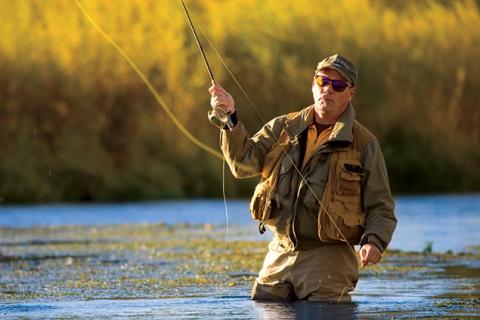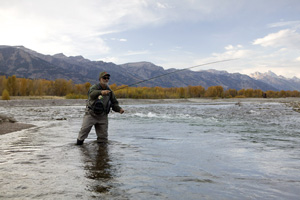
Dry-Fly Line Mending
To the beginning dry-fly angler, the ability to present a drag-free drift probably doesn't seem all that important or difficult compared to the numerous skills needed for a successful day fishing. But, in actuality, being able to drift flies drag-free is just as important as the other skills. Line mending for dry-fly fishing is used to accomplish one main goal: to create a drag-free drift and as realistic a presentation as possible.
 |
| The goal of mending is to create a drag-free drift and as realistic a presentation as possible. |
Surface Currents
Very rarely, if ever, do surface currents become uniform and run at the same speed. Simply put, if you cast your line out straight and allow the line to drift downstream, different sections of the fly line will be pushed faster or slower downstream according to the water's surface current. Surface currents are physically affected by many internal (river bottom composition, submerged snags, etc) and external (wind, rain, etc.) factors that are present along the stream reach. As an angler, it is to your benefit to be able to recognize these different types of conditions and how they affect surface currents.
For example, if an individual were to cast his or her line out across the river, different currents will immediately begin to affect the drift of the fly line. If there was a sunken boulder out near the end of the line, the current will be interrupted there and slower compared to the rest of the water. This slower surface current will cause the tip of the fly line to swing backwards (belly of the line pushed forward) and a small wake to form behind the fly. To counter this affect, the angler should throw a small upstream mend into the faster current and reduce the drag on the fly.
Line Mending Principles
In general, there are two main principles to follow while mending your line while fishing a dry fly:
- The angler should use upstream mends to compensate for faster flowing surface current between the angler and the end of the fly line.
- The angler should use downstream mends to compensate for slower flowing surface current between the angler and the end of the fly line.
Practice Makes Perfect
One of the best techniques to truly learn and understand the dynamics of line mending is to try practice drifting as many different types of water as possible. By casting out towards fishy-looking targets and allowing the line to drift unaltered on the first pass, you will see the kinds of structures that cause surface current changes and how these currents control your line. Then, by simply mirroring what happened on the first cast, you should be able to get a clean, drag-free drift on subsequent casts. Make sure to fish different sections of the stream to familiarize yourself with as many different types of surface current factors as you can. In time you should slowly start to be able to read the water and predict what is going to happen during the drift so you can mend the line as things are happening, giving you a great drag-free drift and the best chance at catching that lunker.
Wet-Fly Line Mending
After you've had a little time to digest the skills and techniques of dry-fly line mending, you will then be ready to move on to the next step: wet-fly line mending. In comparison, wet fly line mending is more complex than dry fly line mending because, not only do you control the swim or action of the fly (swinging the fly across the current), but you also control the level of the fly in the water column. Wet-fly mends differs from dry-fly mends in that, not only does this technique allow fish to get a good look at your fly, but also uses a sultry swimming action to entice fish to strike.
When talking about wet fly line mending, we are considering two general groups of flies to be fished using this technique, which include streamers and soft-hackle wet flies. These two fly groups are deadly when worked by anglers that are able to get the fly where the fish are holding.
River Currents
First and foremost when beginning to wet fly fish, the angler has to realize that the river or stream current is their ally. The current is the medium that will relay the fly to its target and then carry out the swimming action. As the current rushes downstream, the angler has to use the steps similar to dry-fly mending to set up a drag-free drift for the fly. Once this drag-free drift is acquired, the wet fly will slowly start to sink beneath the river surface.
In most cases, the general rule of thumb to follow is, the faster the river current is flowing, the more time (drift distance) you will need to get the fly down deep. To aid in this process, wet flies or streamers are usually slightly loaded with lead-free weight. This concept of getting the fly down in the water column should be very familiar; the nymph-fishing technique is simply what is being talked about here, where you take the slack line and drag out the presentation in order to get the fly drifting deep.
Once the fly has reached the strike zone of the fish, the fast flowing current will again help aid in the presentation of the fly. Allowing the fly line to be mended across the current will drag the body of the fly line downstream at a greater rate than the end of the line, resulting in a swing-like action. Depending on the size of the mend and the speed of the river current, the swing can take place very slow and methodically or quick and expedited. Both speeds of the wet fly swing have worked on fish the world over, but it is up to you to figure out what the fish like best in your neck of the woods.
Wet-Fly Line Mending Principles
In general there are two all-purpose principles to follow in wet fly line mending:
- The angler should use upstream or downstream mends in order to achieve an initial drag-free drift for the fly. This free drift will in turn allow the fly to sink down in the water column.
- When the desired depth is reached, the angler will again mend the line, but this time across the faster flowing current. Fast moving water will cause the belly of the line to be pushed at a faster rate, resulting in an upward swing of fly as it passes its respective target.
Practice Makes Perfect
Just like dry-fly line mending, the key to becoming confident with wet-fly line mending is to get out on the water and practice. Being able to control the fly with wet-fly mends is more difficult than with dry-fly mends because you will not always be able to see the fly. Developing a sense for what's taking place under the water is necessary for anglers planning on consistently fooling fish and staying away from snags. Crystal clear rivers are a good place to start practicing these wet mends because you will be able to see how the fly acts under the surface. Pay close attention to the speed that the fly descends in the water column as compared to the speed of the river. Getting this timing down will tell you how far ahead of your target you will need to cast so that you can be in the strike zone when you start your swing.
Additionally, practice mending into the current will help anglers determine when the fly will swing according to when the mend is placed in the line. The wet fly swing is a technique that needs more that just a few hours of practice to master. Every fishing trip is an opportunity for anglers to further develop their understanding of this tricky technique, while at the same time having a chance to catch fish and have a great day out on your favorite body of water.
- 6571 views

